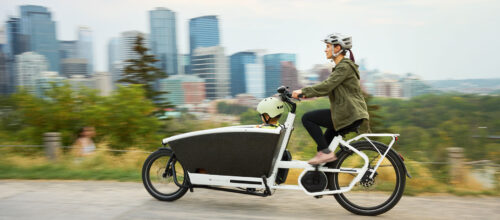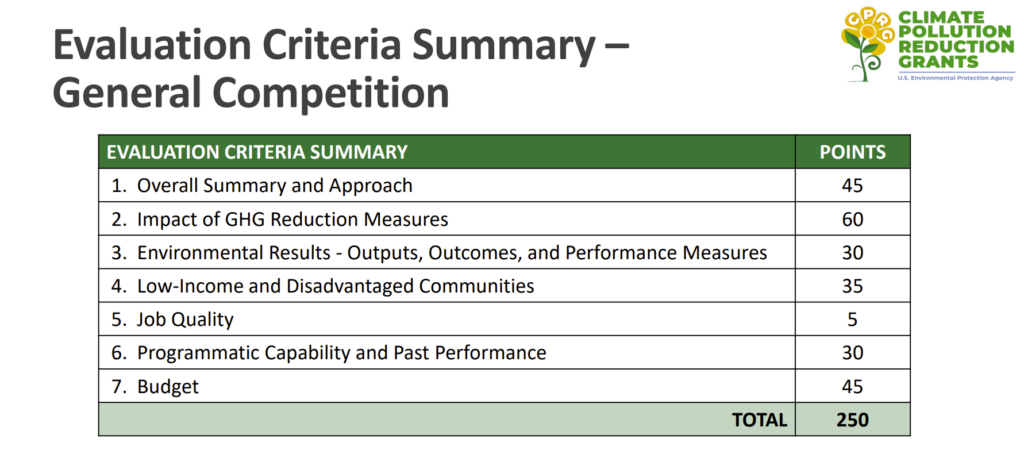
How to Unlock IRA CPRG Funding for the Drivers and Cyclists Most in Need
Introduction
The Inflation Reduction Act (IRA) is on track to turbocharge hundreds of millions of investment dollars into clean transportation projects.
One such “vehicle” to unlock IRA funding for clean transportation projects is the Climate Pollution Reduction Grants Program, or CPRG. CPRG provides $5 billion to the Environmental Protection Agency (EPA) to help states, air pollution control agencies, Tribes, and local governments develop strong climate pollution reduction strategies. This program is structured in two phases: formula planning grants funded with $250 million; and competitive implementation grants, funded with approximately $4.6 billion.
With key implementation grant deliverables coming due in the next few months, it’s important now more than ever for local decision makers to consider what transportation strategies will be most competitive for this EPA funding. Only strategies referenced in a state’s Priority Climate Action Plan (PCAP) will be eligible for implementation awards.
Key Dates for the General Competition
- March 1, 2024: Priority Climate Action Plan (PCAP) due to EPA
- April 1, 2024: Implementation Grant applications due
- July 1, 2024: Award decisions made by EPA (anticipated)
- October 1, 2024: Awards made (anticipated)
- Mid-2025: Comprehensive Climate Action Plan (CCAP) due to EPA
There are excellent resources out there to help decision makers craft the most competitive CPRG application, including detailed guidance on competing for CPRG grants that we released with Evergreen Action. Many states, like Minnesota, recently released Carbon Reduction Strategies that are rich with formulas to calculate the local emissions reduction potential of a range of transportation projects, as required by the EPA.

An example from MnDOT’s Carbon Reduction Strategy of how to forecast emissions reductions from a protected bike lane project.
While each state’s PCAP should involve a full suite of strategies tailored to local needs and the EPA’s scoring metrics, there are two high-impact transport approaches — e-bikes and superuser incentives —worth highlighting that may be underserved in current dialogues.
Uniquely, both approaches may unlock extra points in the EPA’s scoring metrics as they, 1) have clear equity advantages; 2) offer straightforward emissions reductions calculations; and 3) represent incentive gaps that are not otherwise served by federal legislation.
CPRG Evaluation Criteria according to the US EPA.
#1 E-Bikes: A Game-Changer in Clean Transportation
Background
An e-bike, or electric bicycle, is a bicycle with a built-in motor and battery that assists the rider’s pedaling. E-bikes are gaining traction as an affordable and convenient mode of transportation, with national sales doubling since last year and global market size expected to balloon to $92 billion by 2029.
E-bikes produce no tailpipe emissions and use a fraction of the materials needed to make traditional vehicles. In terms of convenience, they are considered an especially promising alternative to car trips for completing short journeys of around 5 miles or less. According to national data, the majority of automobile trips in the United States are shorter than 5 miles.
Recommended Action
Decision makers should consider how e-bike subsidies or ride-share programs fit into a full suite of clean transportation strategies to be submitted in initial PCAP’s to US EPA on March 1, 2024.
For ideas on how to implement such programs, decision makers should consider model policies from Colorado, Minnesota, and hundreds of local communities around the United States. For example, Colorado’s extremely popular statewide rebate program distributed over 4,500 rebates across 54 counties, and 92% of the low-income standard rebates were redeemed.
Why this strategy may boost your CPRG priority plan:
E-Bikes have not yet been addressed in federal legislation, creating a powerful narrative and opportunity to wield CPRG dollars to uniquely accelerate clean transportation adoption.
Using new tools like RMI’s e-bike calculator, it’s easy to forecast the impacts of a specific e-bike subsidy on climate pollution reductions in your state. The calculator is loaded with real-world data from a pilot project in Denver, which demonstrated that subsidies for e-bikes were not only wildly popular, but also led to verifiable greenhouse gas emissions savings due to mode shift from single-occupancy vehicles.
While transit, rail, and EV projects are essential to a clean transportation strategy, all may require large capital expenditures and lengthy approval processes. Meanwhile, e-bike solutions are ready to reduce climate pollution “out of the box” and don’t require expensive associated infrastructure. Bike racks, protected lanes, and flex posts are both affordable and easy to deploy.
Beyond capital and planning advantages, e-bikes can improve mobility equity in ways that are easy to align with CPRG scoring metrics. Pueblo, CO’s, “e-Cycle-to-Own” program for low-income essential workers demonstrates how targeted policy interventions can effectively prioritize e-bike adoption among disadvantaged communities.
CPRG gives bonus points to solutions that reduce “criteria air pollutants,” such as particulate matter, nitrogen dioxide, and carbon monoxide. RMI’s e-bike calculator can forecast how a subsidy program would reduce all three of these criteria pollutants, improving public health in your community while bolstering the competitiveness of your CPRG application. For a full list of CPRG competition metrics, see this slide deck from US EPA.
#2 Superusers: Steering EV incentives to those who need it most
Background
When designing and distributing incentives for electric vehicles, not every recipient has equal impact. Research has shown that most EV incentives flow to upper- and middle-class buyers that likely would have electrified even without the financial incentive. In addition to the economic inefficiency, many of these drivers are purchasing a second vehicle or live in a city and only drive their EV short distances. In both cases, the greenhouse gas emissions and air pollution that are abated through the EV purchase are negligible.
At the other end of the spectrum, a new report from Coltura finds that the top 10% of passenger vehicle drivers in the United States use more gasoline than the bottom 72% of drivers in the country, and nearly as much as all of China combined. The majority of those in this top decile, known as “superusers,” have household incomes of less than $100,000 and spend nearly three times as much of their household income on gasoline when compared to non-superusers. Crucially, the carbon reduction from an average superuser switching to an EV achieves roughly five times as much impact as electrification for an average non-superuser. In this way, dollars spent on superuser incentives can be more efficient and effective than traditional blanket incentives.
Recommended Action
In addition to a full suite of clean transportation strategies, decision makers should consider using CPRG money for programs that specifically identify and financially support superusers to switch to EVs and other clean modes of transportation. To maximize the positive impacts for low-income and disadvantaged communities, a superuser program could have additional eligibility requirements or adders for buyers that fall within these categories.
States like Vermont, Maryland, and California are already enacting or exploring incentives tied to past gasoline usage, directing greater benefits to low-income individuals. To determine eligibility, Coltura recommends using the odometer reading on the certificate of title for the buyer’s gas-powered vehicle and subtracting the odometer reading from a photo or sworn statement of the current reading to derive the average miles driven per year. When divided by the MPG rating of the vehicle, implementers can easily calculate the average annual gallons of gasoline used.
How this strategy may boost your CPRG priority plan:
Superuser incentives hit on several priorities that the EPA has identified in strong CPRG implementation plans. First, a targeted program would specifically benefit the economic resilience and health of low-income individuals and those living in disadvantaged communities. Superusers, the majority of whom live in rural communities or small towns and make under $100,000, are more vulnerable to fluctuating gas prices and the additional repairs required by fossil-fuel cars. Electrification could save superusers thousands of dollars a year in gasoline costs alone. In addition to driving more miles and therefore emitting more air pollution overall, superusers are also more likely to drive older vehicles, which emit more pollution per mile. Electrifying these drivers will create an outsized benefit in low-income neighborhoods that tend to be more vulnerable to air pollution.
Regarding the CPRG’s cost-effectiveness criteria, superuser programs guarantee that states get the most “bang for their buck” when investing in EV incentives, as mentioned above. In spite of the savings potential, these largely rural drivers tend to be some of the most difficult drivers to convert to electric vehicles, which means that they will likely require sizeable per-vehicle incentives. Most existing funding streams simply can’t meet this demand, which is why CPRG is uniquely qualified to serve as a funding source.
In addition to the equity and emissions impact, superuser programs excel in the CPRG’s performance measures criteria. Because program officers will need to calculate the average annual gallons of gasoline used by each applicant during the eligibility assessment, reporting on abated emissions will be incredibly straightforward.
Conclusion
RMI’s recent State Scorecard analysis found that most states have a big gap to fill if they hope to achieve at least a 50% reduction in greenhouse gas emissions by 2030, and transportation emissions make up the largest share of emissions in most of these states. E-bike and superuser incentive programs can rapidly and equitably decarbonize this sector and are also likely to be uniquely competitive for CPRG Implementation grants, based on EPA’s guidance. Decision makers should act quickly to ensure that these two programs are included in their state’s CPRG Priority Climate Action Plans and eligible for the $4.6 billion of Implementation Grant funding.
